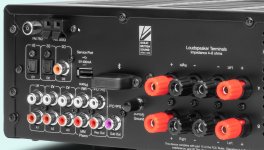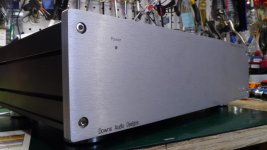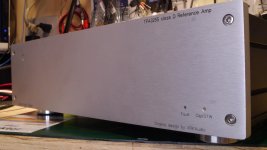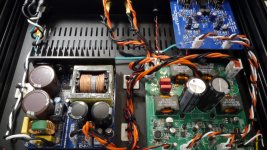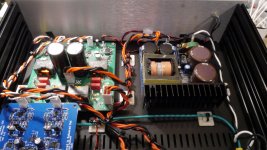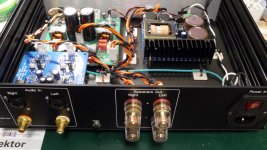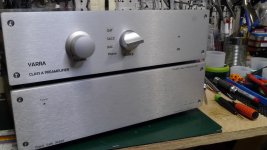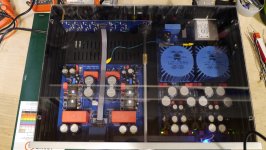Awesome redjr, I really like the marking upside down. I’m not sure but I think it’s the first time I see that, clever!
I got a tracking number from connex and by the look of it it’s slowly on its way.
@randytsuch? It could help to know the sensitivity of your speakers and the size of your room, I think knowing if you’ll get enough power out in the SE configuration is the first thing to confirm.
Thanks for the comment. Hopefully. I'll have some pics of my front panel in better light and will post soon.
Regarding the upside down labeling... Actually I first saw this on a Cambridge Audio piece of kit (see picture), and thought it was a neat idea. I've since seen it on the top labels, as well as bottom. I chose the bottom. The theory is.... we often find ourselves looking at the back of equipment from the front with our head upside down! 🙂
Attachments
The theory is.... we often find ourselves looking at the back of equipment from the front with our head upside down! 🙂
I had a similar experience, Aragon equipment does the same on their rear panels. I didn’t get it....until the first time I looked over the top with my head upside down 😀
Nice detail redjr!
The FH9HVX is a superb Class AB amp capable of satisfying even the most discerning listener ...
Thanks for the long, detailed answer.
It did help. I've done a lot of SM so I think I can assemble this board, but easier is always better lol.
And the FH9HVX seems to suit my purpose better anyway.
Will move to that thread now.
Randy
Final TPA3255 Reveal
I finally finished the X masterpiece, class D amp TPA3255. I have to say upfront, the noise floor on this thing is phenomenal. It is ultra quiet! I immediately paired it with my Yarra pre, with the installed Korg, Nutube 6P1 'tubes'. The sound simply blew me away. The dynamics, articulation and presence of every note across the spectrum was obvious. It was like having HDR for my ears! The combination of the Yarra and the 3255 brought my Elac Uni-Fi, UB5 speakers to a new level of performance. Can you tell I'm pleased? Even my son thought it sounded great, and said, "so does this mean you going to get rid of your Parasound amp?" 😀 And, I haven't even tried the full chain of balanced cables using my Doug Self pre yet either! 🙂 I think there's still more goodness to come.
Below are a few more pictures of the amp and the 'impressive duo'. In the Yarra case, I had to use stick-on tape for my selection labels. The last image is an inside view of the Yarra with the Nutube 6P1 on.
Thanks to X and his design team for bringing such fun and well-executed audio projects to the DIY community. They are a pleasure to build, and with the help of others on the forum, make it an exciting place to experiment and learn. In the end, we are left with a very nice piece of kit that's a pleasure to listen to and use. And will bring a level of accuracy for years to come to the music we all love to listen to.
Back to more listening....
I finally finished the X masterpiece, class D amp TPA3255. I have to say upfront, the noise floor on this thing is phenomenal. It is ultra quiet! I immediately paired it with my Yarra pre, with the installed Korg, Nutube 6P1 'tubes'. The sound simply blew me away. The dynamics, articulation and presence of every note across the spectrum was obvious. It was like having HDR for my ears! The combination of the Yarra and the 3255 brought my Elac Uni-Fi, UB5 speakers to a new level of performance. Can you tell I'm pleased? Even my son thought it sounded great, and said, "so does this mean you going to get rid of your Parasound amp?" 😀 And, I haven't even tried the full chain of balanced cables using my Doug Self pre yet either! 🙂 I think there's still more goodness to come.
Below are a few more pictures of the amp and the 'impressive duo'. In the Yarra case, I had to use stick-on tape for my selection labels. The last image is an inside view of the Yarra with the Nutube 6P1 on.
Thanks to X and his design team for bringing such fun and well-executed audio projects to the DIY community. They are a pleasure to build, and with the help of others on the forum, make it an exciting place to experiment and learn. In the end, we are left with a very nice piece of kit that's a pleasure to listen to and use. And will bring a level of accuracy for years to come to the music we all love to listen to.
Back to more listening....
Attachments
Hi Redjr,
I am so pleased that you are delighted with this amp! Thank you for the kind words. I have JPS64 and Jhofland to thank for the phenomenal design.
I am so pleased that you are delighted with this amp! Thank you for the kind words. I have JPS64 and Jhofland to thank for the phenomenal design.
Wow, the perfect pair!! Very neat looking inside out. A real new school system: smps/class D/nutube. I must say I’m a bit jealous, I would love to have a Nutube preamp. Is it like the diy audio store Korg B1 nutube preamp with the feature that let you decide the amount of 2nd harmonics you want to mix in, a kind of a dry/wet nob for effects on a guitar amp.
The YARRA Preamplifier/HPA for Melbourne DB Group Buy
If there is interest in more Korg 6P1 preamp modules I could order more pcb’s.
If there is interest in more Korg 6P1 preamp modules I could order more pcb’s.
Wow, the perfect pair!! Very neat looking inside out. A real new school system: smps/class D/nutube. I must say I’m a bit jealous, I would love to have a Nutube preamp. Is it like the diy audio store Korg B1 nutube preamp with the feature that let you decide the amount of 2nd harmonics you want to mix in, a kind of a dry/wet nob for effects on a guitar amp.
Thanks for the kinds words everyone.
@Francisdumas, No, I don't believe you can 'dial-in' any H2 amount. Maybe a better question for X.
The relative H2/H3 is somewhat adjustable. However, the lowest overall THD and balance of H2/H3 puts it at about 0.024% THD for a certain recommended grid voltage of 12.0v. More info here:
The YARRA Preamplifier/HPA for Melbourne DB Group Buy
My personal choice would be to use a Hakuin or PCA daughterboard for the Yarra to do the same thing as they are even quieter than the Korg and more robust and less expensive.
Here is the Hakuin - one of the finest preamp modules I have heard.
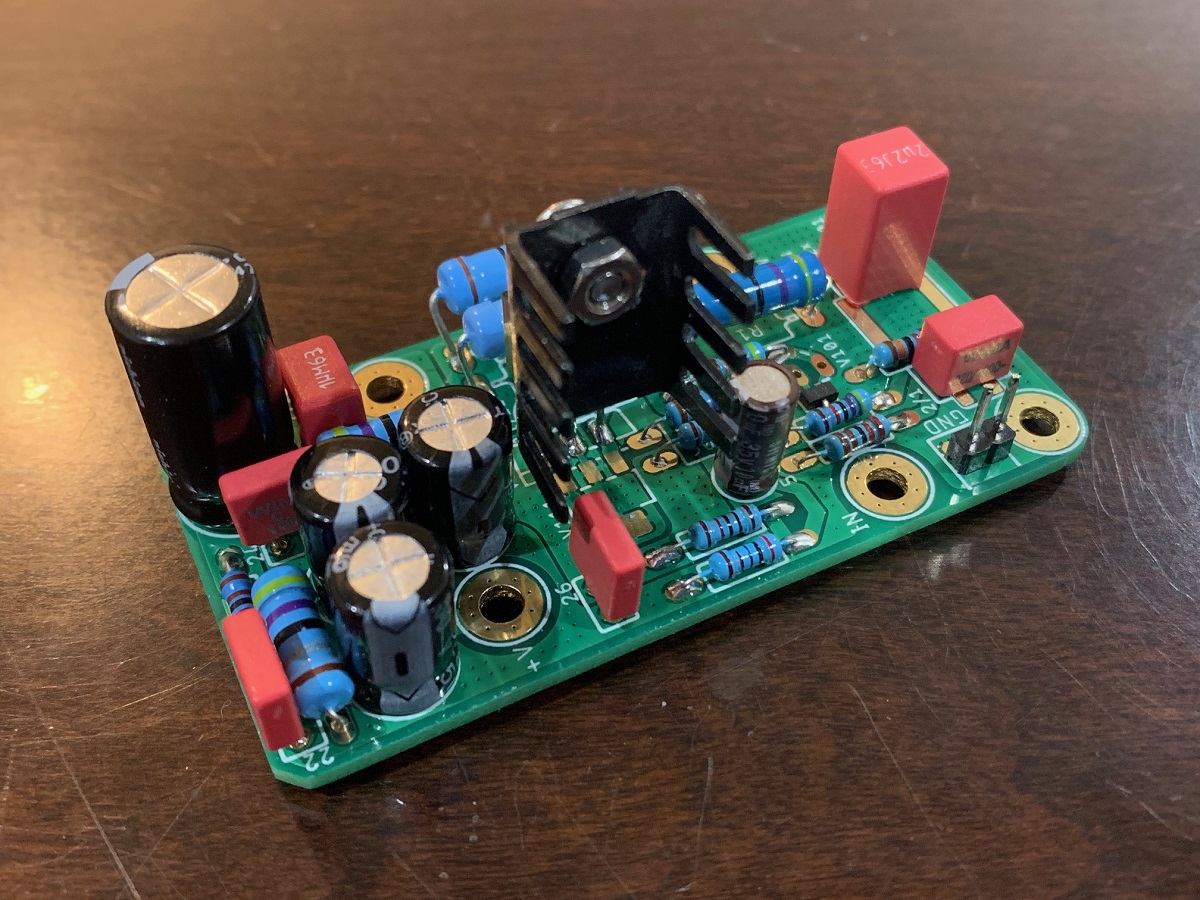
Your choice of 2sk170 or 2sk209 (or even BF862):
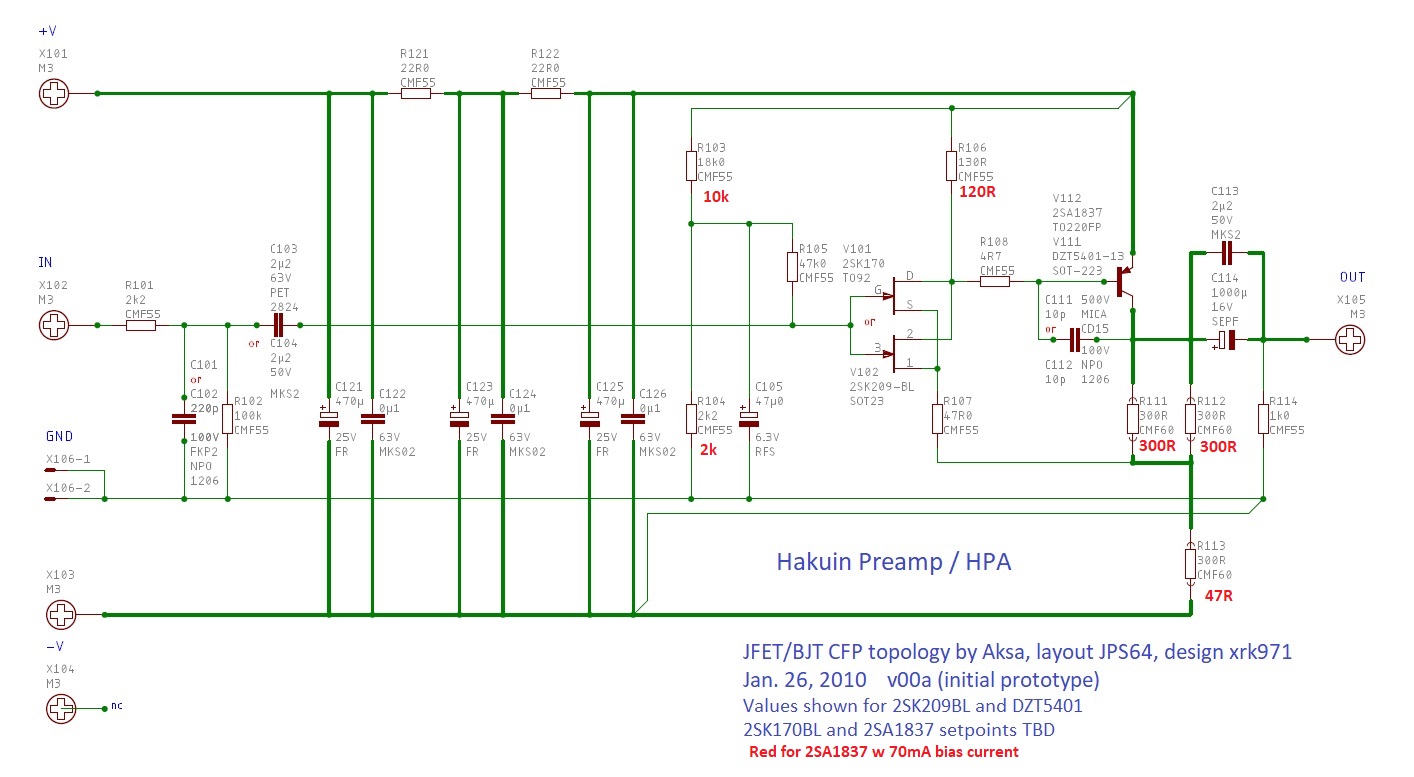
Predicted 1Vpp into 250ohms:
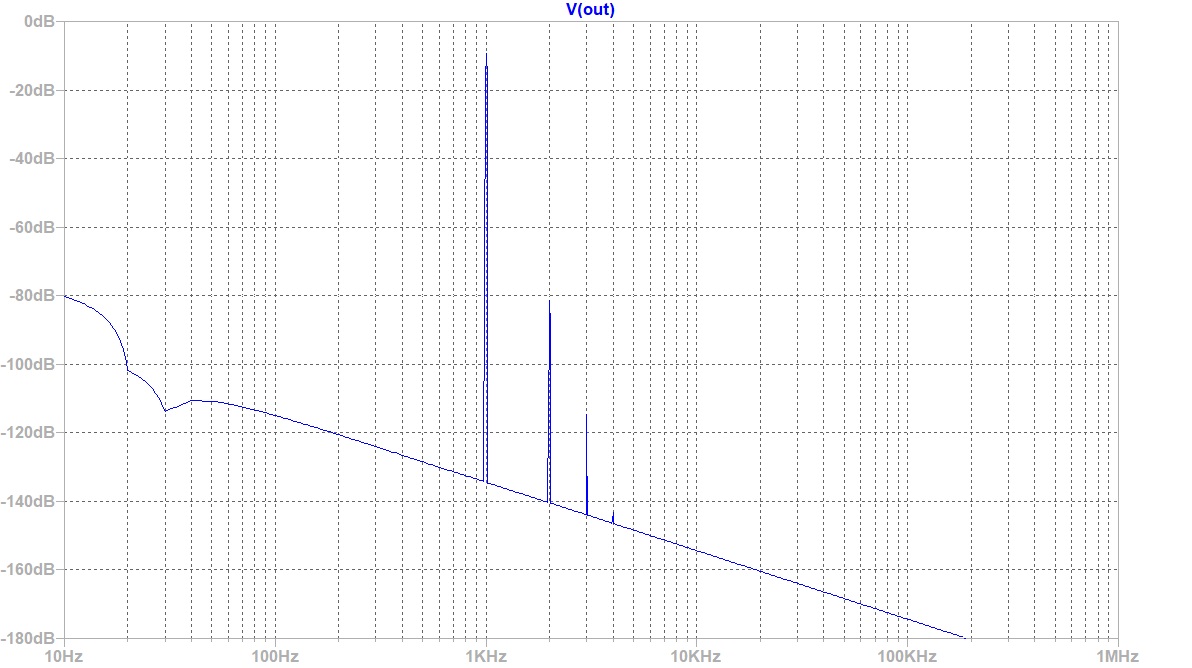
The YARRA Preamplifier/HPA for Melbourne DB Group Buy
My personal choice would be to use a Hakuin or PCA daughterboard for the Yarra to do the same thing as they are even quieter than the Korg and more robust and less expensive.
Here is the Hakuin - one of the finest preamp modules I have heard.
Your choice of 2sk170 or 2sk209 (or even BF862):
Predicted 1Vpp into 250ohms:
Well, maybe I’ll revisit this option in 2021. Right now I’m putting my money aside for the buffer board. Could you let us know an approximate of its price XRK971?
Cool, is there an option to get it assembled or just the surface mounted items installed? And do you have an estimate of the BOM?
Yes, I’ll have the option for the SMT parts installed. I seem to recall that BOM cost was in the $40 range. Can’t remember exactly. I’m on vacation at the moment so don’t have access to all my files. I’ll post it as a new GB as soon as I get back.
I am interested in a GB for the TPA3255 (RTR) if the price is right?
Could not find it here on on your etsy page of xrk971.
Furthermore I am interested in the the Yarra pre-amplifier with Korg 6P1.
Are these also sold as (RTR)? and for what price?
Could not find it here on on your etsy page of xrk971.
Furthermore I am interested in the the Yarra pre-amplifier with Korg 6P1.
Are these also sold as (RTR)? and for what price?
Hi RFN,
The RTR TPA3255 amps from the first GB are sold out (they were selling for $227). If we have more interest, I can make another GB, but the price will be higher at $277 if we can get 15 interested parties to sign up - as I discovered the huge amount of time required to get the production made, tested, packed and shipped was not viable at the $227 price). Currently, the only way for you to have one now is to DIY it from a PCB, which I have plenty. PCB is $38, Mouser BOM is about $120.
The Korg 6P1 Yarra daughterboard is not available at present as sold out but I can order more if there is interest. It is not available as RTR as they are easy to solder through hole parts.
The RTR TPA3255 amps from the first GB are sold out (they were selling for $227). If we have more interest, I can make another GB, but the price will be higher at $277 if we can get 15 interested parties to sign up - as I discovered the huge amount of time required to get the production made, tested, packed and shipped was not viable at the $227 price). Currently, the only way for you to have one now is to DIY it from a PCB, which I have plenty. PCB is $38, Mouser BOM is about $120.
The Korg 6P1 Yarra daughterboard is not available at present as sold out but I can order more if there is interest. It is not available as RTR as they are easy to solder through hole parts.
I'm considering your PCB plus BOM from Mouser. I've gone through the thread to find out where you made changes from TI's EVM. One particular one that I noticed is the change to 3R3 instead of 1R [per TI's recommendation] in the PFFB circuit. Were you after some specific change to the PFFB circuit behavior?
Cool, is there an option to get it assembled or just the surface mounted items installed? And do you have an estimate of the BOM?
Vunce tells me the BOM is closer to $65 for the BTSB Buffer - sorry I was off. One of the problems with having a pretty stocked bench is that I don't always have to order all the parts on the BOM, so the full costs (from scratch) don't always stick in my head.
@grufti
One particular one that I noticed is the change to 3R3 instead of 1R [per TI's recommendation] in the PFFB circuit
Please tell me the component label you are referring to. If you are talking about R261/262/263/264 those are the resistors for the output Zobels (oscillation snubbers). In the TI EVM Fig 7, schematic 2, they are labeled R11/14/18/22 and are the same value 3.3R coupled with 0.01uF X7R caps. Note that the EVM has no post filter feedback (PFFB) implementation.
If you are talking about the Zobel values recommended on the PFFB app note, you are correct, TI does have 1R paired with 220nF, which is about 7x stiffer of a Zobel vs the no PFFB case. I did not run into any oscillation issues with the 0.01uF and 3.3R setup and prefer it as it allows switching between no-PFFB and with-PFFB easily. But if you are running only in PFFB mode, changing to the 220nF and 1R combo should work well. The main thing to note is to never drive a Class D amp at high power without a load attached in any event (which is why the 220nF and 1R values were chosen for open circuit stability).
The (good) final production schematic is only available once you buy the board - I have not posted it for IP reasons to protect from unscrupulous eBay/Aliexpress/China-based vendors willing to blatently copy and sell a board.
Last edited:
Thank you x. Your detailed answer to my terse question addressed exactly what I was talking about - TI's PFFB app note vs your choice of components.
You have raised one other question though. How can you easily switch between no- and with-PFFB? I was going to run only with-PFFB, but if I can find a way to switch easily then I might want to do that also.
You have raised one other question though. How can you easily switch between no- and with-PFFB? I was going to run only with-PFFB, but if I can find a way to switch easily then I might want to do that also.
- Home
- Group Buys
- TPA3255 Reference Design Class D Amp GB
